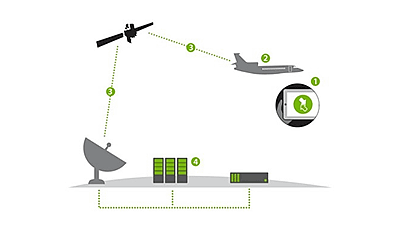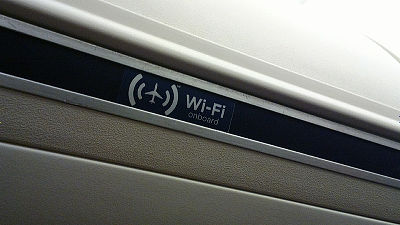How is an internet connection provided by an airplane flying over 10,000 meters?

by
According to a survey conducted in 2018, 94% of airplane passengers answered that `` the travel experience is improved by being able to connect to the Internet on the airplane, '' and 30% say `` in-flight W-Fi can be used for flight reservation reasons. '' It seems to have answered 'From'. Writer Sarvesh Mathi explains how the Internet connection environment is prepared by an airplane flying at an altitude of nearly 10,000 meters at a speed of 900 km / h.
The Magical Science of Wi-Fi on Airplanes-OneZero
https://onezero.medium.com/what-makes-it-possible-to-browse-the-internet-at-35-000-feet-1afaea83eb5
According to Mathi, there are two main ways an airplane can connect to the Internet.
◆ 1: Air To Ground (ATG) system
In the ATG system, as the name 'Air To Ground', it communicates by exchanging radio frequency signals between a radio tower installed on the ground and an airplane.
For example, in the ATG-4 system released by Gogo , an in-flight internet service provider, two antennas for catching radio from the ground are installed under the airplane's belly and two on the side. Also, there is a server in the aircraft, and several Wi-Fi antennas for passengers to connect are installed in the aircraft, and the system itself can be introduced to the airplane overnight. And it seems that more than 200 radio towers for the ATG-4 system are installed throughout the North American continent.

However, according to Mathi, the ATG system communicates with a low-frequency radio wave of 800 MHz, so the communication speed during the flight is limited to 10 Mbps at best. At this speed, it's enough to check emails, but you can't expect comfortable internet surfing. Also, if you fly over an area where there are few radio towers, such as the desert or the sea, you will not be able to connect to the Internet. Therefore, although the ATG system is often used for domestic flights, it is rarely used for international flights.
◆ 2: Satellite system
In addition to the ATG system, there are other systems that use artificial satellites to realize the Internet on the plane. Airplanes that support this system are equipped with antennas at the top, and can communicate with a data center on the ground via a satellite that orbits the earth. The satellite system can communicate anywhere except the North and South Pole.

In the satellite system that Gogo provides, of the band of 18GHz from 12GHz
However, in order to receive the signal from the satellite, the antenna mounted on the airplane must always rotate in the direction of the satellite. Satellites that communicate with airplanes move at the first space velocity of 7.9 km / s, and it is necessary to perform complex antenna control with high accuracy, so the maintenance cost is overwhelmingly higher than the ATG system. It will be a drawback. The following image is an antenna that exchanges signals with the satellite.

Another disadvantage of the satellite system is that the communication lag increases because the data communication distance increases. Furthermore, Mathi points out that satellite system antennas are mounted on the outside of the airplane, which increases the air resistance of the airplane depending on its shape, leading to poor fuel consumption.
According to Mathi, many airlines have found profitability in in-flight internet connections, with paid internet connections ranging from $ 15 ($ 1600) to $ 20 ($ 2200) per flight Plans that provide plans are also increasing. Gogo is also pushing ahead with a plan to provide 5G mobile communications systems (5G) to machines with ATG systems in the US and Canada by 2021.
Mathi said, “With better satellites, better antennas, and more Internet service providers joining, you can connect to the Internet comfortably on an airplane just as you would at home. Sadly, this means that the excuse 'I couldn't reply to the email because I was on a plane' won't work. '
Related Posts:
in Vehicle, Posted by log1i_yk







